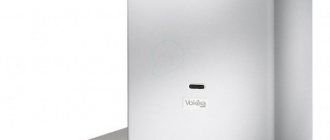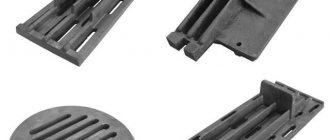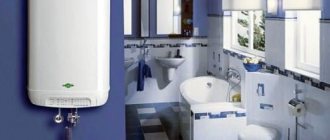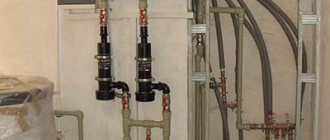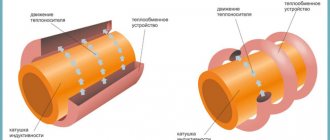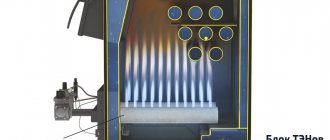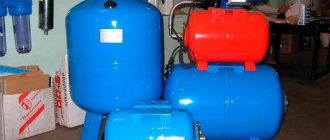In this article I am going to tell you how a boiler differs from a water heater in terms of design and consumer characteristics. In no case do I want to make any final verdict on the advantages of one or another solution: the purpose of writing this article is to explain to a potential buyer the key features of both devices and to share my own experience of using them.
Boiler in the bathroom on the first floor of my house.
First meeting
First let's look at the definitions:
- A boiler , or storage water heater, is a thermally insulated tank with a heating element. The latter is played by a heating element, gas burner or heat exchanger connected to the heating system and boiler (the so-called indirect heating boiler);
- An instantaneous water heater is a heat exchanger that heats water as it flows. The water tank inside the water heater is a very small container, the only function of which is to ensure water contact with the maximum area of the heat exchanger and prevent its overheating.
Flow-through heater in the attic bathroom.
A tank with a heat exchanger inside the device.
Together, a massive boiler and a compact flow-through device resemble characters from a famous cartoon.
Do you recognize?
So: the main difference between a water heater and a boiler is that the first heats water as it is consumed, and the second creates a supply of water heated to the desired temperature.
Boiler or water heater: what are the differences?
Any home requires comfortable conditions, and hot water is an important factor. But for city apartments and country houses, this problem is not always solved with the help of centralized water supply. For this purpose, special water heaters are used, the power of which and design may vary. Among the equipment offered on the market, there are various device options that differ not only in the power of the water heater, but also in the principle of heating water.
Scheme of operation of a stationary boiler.
But what is the difference between a boiler and a water heater? Which one can be used for installation in a city apartment, and which one is suitable for providing hot water to a large system and a private house as a whole? Let us answer this question by considering the individual characteristics and features of such equipment.
Features of storage boiler
What is the difference between a boiler and a water heater? They are similar in many ways, but there are some differences. If the coolant in the heater is heated from a special heating circuit, then such equipment is an indirect heating boiler. What is this?
Storage boiler connection diagram.
A coil is installed in a cylindrical metal body, the top of which is covered with enamel. It is such a coolant, that is, a water heater. When a boiler of this type is connected to a heating system, several problems can be solved at once. This is not only the provision of hot water, but also the supply of coolant for the heating system.
A storage boiler is a device in the form of a cylindrical metal tank, the power of which depends on the model. Some models can hold several hundred liters. For large boiler houses, large vertical installations are used, and for private houses, the use of more modest equipment, the power of which is much less, is allowed.
In any case, you will have to allocate a separate room to place the boiler; this can be done in the house on the ground floor, or it can be installed in separate outbuildings.
Such a storage boiler must be attached to the wall surface.
Its body is made of plastic or stainless steel. The surface is steel, painted using special paints or covered with a layer of enamel. But when choosing, you will have to take into account that steel is susceptible to corrosion, so you need to choose stainless steel types, not ordinary ones. In this case, the service life of the container will be much longer.
The design of the boiler is as follows: in the barrel itself there is a coil, which is made of brass or steel; its shape resembles a spiral, but the increased number of turns allows you to heat the water much faster. The coil is shifted closer to the bottom of the boiler, since cold water tends to sink down when heated, that is, the water heats up evenly and quickly.
Scheme of the storage boiler device.
There are models that have two heating elements at once, for example, indirect heating devices. One of these heat exchangers is powered by the heat pump, and the other by the heating system.
The principle of operation of a storage boiler is simple. Cold water is pumped into the lower part of the container, after which it is gradually heated by a heat exchanger. For hot water, the outlet is located at the top. The device is equipped with a magnesium anode, which extends service life.
There are some boiler models without a coil. Such equipment consists of two containers, in one of them (smaller) water is heated, the walls between the tanks are a heat exchanger.
Electric storage water heater: looking for differences
Today, many people prefer to use an electric boiler. This is often called a storage water heater powered by an electrical network. Such equipment differs in size; the tank volume can range from 5 liters to 120, it all depends on the needs of the living family. If you need to install equipment for washing dishes in the kitchen, then it is best to choose a small heater with a capacity of 5 liters, but a large one, designed for a volume of up to 120 liters, can be used not only for the bathroom, but also for the kitchen at the same time.
The power of such a storage tank can be different; in this case, you need to choose exactly the equipment that suits you best both in terms of electricity consumption and volume. For an apartment, such power may be small, but for a private house it is usually quite significant parameters. Typically, the use of a storage heating tank is recommended for a family of three to six people; a volume of 100 liters is quite enough for daily needs.
Connection diagram for storage water heater.
Using an electric storage device is preferable in many cases. Inside the device, in addition to the installed thermal electric heater, the so-called heating element, there is also a magnesium anode, a special thermostat. This allows you to heat the water to the required, comfortable temperature. There is a type of storage heater that is equipped with a dry heating element, that is, the heating element for such equipment is not in the water, but outside it; it heats only the internal container. The service life of such a storage heater is much longer, but the cost of such units is also higher.
Gas storage devices have completely different power and characteristics. They are classified according to the following criteria:
— for forced draft with a closed fuel (gas) combustion chamber;
- to ensure natural draft, that is, with an open chamber for fuel (gas) combustion.
The cost of such equipment is quite high, and installation is somewhat complicated. During installation, many factors should be taken into account, this is not only the power of the equipment, but also the provision of exhaust hood and other safety conditions.
Why do gas water heaters still continue to be popular? The thing is that they run on cheaper gas, that is, their use is more economical, and this is important for a large private house.
Diagram of operation of an electric water heater.
Using a storage water heater allows you to solve such a problem as ensuring an uninterrupted supply of hot water, which is often necessary not only for a private house, but also for a city apartment. In this case, the use of flow-through systems is ineffective, and if there are several water collection points, then it is best to use heaters with tanks whose power corresponds to the stated needs of consumers.
But many are not happy with the different situation. For example, if someone is washing in the bathroom, and at the same time the dishwashing tap is turned on in the kitchen, then a sharp drop in temperature is immediately observed. The situation can be corrected by installing an indirect type water heater.
For a large family, such equipment is simply irreplaceable, especially if it is installed in a private house where there is not one bathroom, but several. This allows all family members to use hot water normally, who will no longer have to wait for their turn.
Today, indirect storage heaters are the most popular installation option. They are compact, easy to install and use, and provide hot water consumption at the required temperature.
How is a boiler different from a typical water heater?
Water heater design diagram.
So how can a boiler familiar to many differ from a water heater if the principles of their operation are almost the same? Quite often, due to some external similarity and almost identical use, a boiler is also called a storage water heater. But inside a real water heater there is only a heating element, but the boiler has a heat exchanger into which the coolant from the boiler is supplied. The upper part of the boiler tank has an anode holder, a flange with which a thermostat sensor and a thermometer are placed inside. That is, there are design differences that are quite significant.
For a boiler, the heat source can be electricity, gas (natural, liquefied), diesel fuel, solid fuel (wood, coal and peat briquettes, regular coal, pallets). The main similarity that boilers and water heaters have with each other is the presence of a water tank made of stainless steel or with an enamel coating, in which the water is heated. But unlike a water heater, a boiler is designed to heat a fairly large volume of liquid; some tanks are designed for three thousand liters. Naturally, the power of such a unit is greater.
Basically, the use of such a massive boiler is intended for a house with several water points. A small and compact water heater is ideal for a city apartment, providing water at a comfortable temperature. Indirect water heaters are ideal for cottages; they are quite large in size, but at the same time they are economical.
Take your time when purchasing a water heating device, analyze your needs. We hope that our advice will help you in choosing exactly the equipment that is suitable for a particular situation.
Load on the electrical network
The differences between a boiler and a water heater include, but are not limited to, significant differences in power consumption.
Flow heater
The minimum electrical power of the device is 3.5 kilowatts. Just such a device – Atmor Basic – is installed in my attic bathroom. The power consumption allows you to connect it to a regular European socket.
Attention: to avoid overheating, hidden wiring should be calculated based on a maximum current of 8 amperes per square millimeter of copper wire cross-section. If so, for a current of 16 amperes, corresponding to a consumption of 3.5 kW, you need wiring with a cross-section of at least 2 mm2.
A 3.5 kW appliance can be plugged into a wall outlet, but has strict wiring requirements.
The maximum power of commercially available electric flow heaters is 24 kW. They are connected only with a separate cable thrown from the panel, and only to networks with a voltage of 380 volts.
Gas appliances, for obvious reasons, are undemanding when it comes to wiring: the required power consumption is provided by the burner.
However, their operation requires compliance with certain safety measures:
- Installation is only possible in a room with its own ventilation duct;
- The device needs a constant flow of fresh air into the room where it is installed.
Boiler
The typical power of an electric boiler is from 1.3 to 2 kW.
The power of my boiler is 1.5 kilowatts.
It can be connected to any electrical outlet with a wire cross-section of 1.5 mm2. Connecting via an extension cord is not advisable, but is possible if absolutely necessary.
The photo shows a socket for connecting a boiler.
Which water heater is better?
When choosing, you should focus on a number of parameters. Among them the following stand out:
- Water heating time . Storage boilers spend at least 40 minutes on the process of heating cold water (excluding the temperature control function and constant switching on of the device). Instantaneous water heaters provide hot water instantly and at any time of the day.
- Number of sources connected to the device . In the boiler it starts from 2 and supplies the entire water supply system where there is a need for hot water supply. Flow devices are installed in the place that will be used to supply water. They can be designed for one point, or supply water to all rooms. The power and energy consumption depend on the number of points.
- Energy consumption . It directly depends on the power of the device and with intensive use of the equipment the difference is not too significant. Instantaneous water heaters consume more electricity to quickly heat up the water. The operating time of the device is a short cycle. The boiler uses less energy. The usage time fits into a long cycle. As a result, the design consumes less electricity, but with prolonged heating and the need to maintain the temperature, the consumption will be significant. In terms of efficiency, a stationary boiler outperforms competitors who spend more energy resources on quickly heating water.
- Maximum heating temperature. The highest temperature is produced by a standard storage water heater. It reaches 75 degrees. A low-power instantaneous water heater heats water up to 40 degrees. A powerful flow-through heater with several connection points heats water up to 60 degrees.
- It's a question of price. Storage stationary boilers cost from 7,500 rubles to 16,000 rubles. Flow mobiles heat water up to 40 degrees and cost from 2,000 rubles to 5,000 rubles. Flow stationary ones cost from 6,500 rubles to 16,000 rubles.
When choosing between an instantaneous water heater and a storage boiler, you should focus on your needs and budget. When you have a small amount of space and many users, you need high performance and a small tank capacity. Then the optimal solution would be a stationary flow apparatus. It will be able to provide high-speed water supply to any number of users.
If it is necessary to install a water heater in a room with a lot of space and a small number of users, it is possible to install a stationary device with a tank capacity of up to 100 liters.
Modern boilers are equipped with modern control systems. They can be controlled via a mobile application, while simultaneously monitoring water consumption. It is possible to set the heating at times when nightly reduced electricity tariffs are in effect. This is an opportunity to significantly save on energy.
The presence of adjustment in the range of up to 80 degrees and with an accuracy of 1 degree. Some models have an anti-freeze function. It prevents the water inside the structure from freezing and automatically maintains a temperature of at least 5 degrees.
There is a disinfection function. It is required to ensure high quality of supplied water and purify it from microorganisms. Heat treatment and a special surface ensure the use of already disinfected water.
Modern boilers have functionality to maintain the temperature in optimal energy consumption mode. This function is used when the device is not actively used. There are also other functions that make control more comfortable and high-quality, including remotely.
The surface of storage boilers and heating elements are equipped with a special coating that prevents the formation of scale. The presence of coating is relevant for places where water is supplied of low quality.
Flow heaters are actively used to ensure high-quality water supply to premises. They can be hidden from prying eyes, and cumulative ones do not lend themselves to such visual adjustments. Flow-through systems can be used for many years without the need for replacement or special maintenance.
Temperature stability
Which is better - a water heater or a boiler - in terms of output temperature stability? Agree that its fluctuations are quite unpleasant when trying to wash dishes and especially take a shower.
| Flow-through | Cumulative |
| With a fixed heating power, the temperature rises relative to the original by a fixed number of degrees. In winter and summer, the water temperature at the same pressure will differ by 10 - 20 C | The outlet water temperature is always constant. It is determined by the manually set position of the thermostat on the boiler body |
I noticed another unpleasant moment in the operation of the flow-through heater. In winter, the temperature of the water inside the water supply located within the heated room differs markedly from the temperature in the water supply main. As a result, after a few minutes of taking a shower, the water suddenly cools down.
Separately, it is worth mentioning the gas flow-through heater (gas water heater). In it, the water temperature is regulated automatically - a bimetallic or digital thermostat. The thermostat is activated when the outlet water temperature drops and increases the burner flame.
However, the rather low accuracy of adjustment and the large inertia of temperature changes make trying to take a shower a constant struggle with the lever or taps of the mixer. As the water pressure increases, the burner ignites and quickly heats the water to an uncomfortably high temperature; when reduced, the water cools just as quickly to ice cold.
Geyser.
What is an instantaneous water heater
An instantaneous water heater is a relatively new device designed to heat water. The principle of operation is to heat water as it flows. This allows you to ensure that there are no water limits and that you can use as much hot water as you need. An instantaneous water heater is called a column. It has different capacities, which are selected according to the number of users and the average hot water consumption per person. Speakers can be electric or gas. The type of energy carrier does not greatly affect the efficiency of use and heating rate. Electric modern designs are characterized by increased compactness. Classic geysers are large and pose some danger due to the need to work with an open source of gas. Both options are common and actively used at home.
Adjustment accuracy
In this parameter, the difference between a boiler and a water heater is that it allows you to set the target outlet temperature with maximum accuracy. The thermostat scale, as a rule, is devoid of graduation, but the trial and error method allows you to quickly select a comfortable temperature.
A flow-through heater, alas, cannot set a constant outlet temperature at all - simply due to the fact that by supplying constant power, you can heat the flow by a certain number of degrees. Following the inlet temperature, the outlet temperature will change.
No, you can still regulate it.
For this purpose they serve:
- Stepwise adjustment of heater power. In particular, Atmor Basic allows the use of power of 1.5, 2 and 3.5 kW;
Step power regulator.
However: power other than 3.5 kW is used only during the peak of the summer heat. In winter, 3.5 kilowatts is enough to heat the minimum flow of water to the minimum comfortable temperature.
- Manual pressure adjustment. The higher the flow, the lower the temperature.
Economical
Electric boilers - water heaters are much less economical than instantaneous ones.
There are two reasons for this.
- Due to the limited power of instantaneous heaters, their creators have to limit the flow of water through the device. This, in particular, is achieved by using special shower heads and shower heads with a small clearance. Less water consumption means less energy consumption;
Standard watering can with reduced nozzle size.
- More importantly, the boiler periodically turns on the heat to compensate for heat loss through the insulation. A layer of polyurethane foam about 5 cm thick protects the tank from cooling quite reliably; however, from 1 to 3 kWh per day is still spent just on heating the atmosphere around the boiler.
Price
At the time of purchase, the price of the heaters installed in my house was:
- Flow-through Atmor - about 2000 rubles;
- Storage Atlantic with a tank of 80 liters - about 6,000 rubles.
Prices have increased slightly since then, but the trend continues today: the boiler is noticeably more expensive.
In the upper price category there are combined boilers - water heaters with a tubular heat exchanger, which allows you to connect the device to the heating network as an indirect heating boiler, and a heating element to maintain the temperature at peak load or when the heating boiler is turned off. In this category, prices start from 27 – 30 thousand rubles.
Installation
In the simplest version, a flow-through heater with its own gander or shower can be easily connected with your own hands directly to the mixer, without altering the liner.
Connection instructions look like this:
- The faucet switches from gander to shower;
- The shower head is removed;
- The shower hose is connected to the heater inlet.
The nozzles have standard pipe thread size DN 15.
For a permanent installation of a flow-through heater, I mounted a separate faucet with a ceramic axle box on the edge of the bathtub.
Instantaneous heaters installed in a water pipe break (for example, Atmor In-Line) do not require any additional devices for installation. The only type of fittings that may be required for connection is a reducer that reduces excessively high pressure to that recommended by the manufacturer (for the notorious Atmor In-Line - no higher than 7 kgf/cm2).
Please note: the manufacturer allows the use of flexible hoses for connection, which greatly simplifies installation.
Diagram for connecting a flow-through heater to a water supply rupture.
The boiler has a separate safety valve added to the reducer.
Safety valve at the boiler inlet.
It is installed at the inlet of the heater; The relief valve can be connected to the sewer. It is strongly recommended to use rigid connections for installation.
This is how the storage water heater is connected.
It is better to connect the device with rigid connections.
There is one more subtlety in installing devices:
- Most storage heaters are wall mounted. Of course, only for capital ones. The owner of a bathroom with plasterboard walls will have to look for a boiler in a rather rare floor-mounted design;
- The flow device with its weight of 1-2 kg can be installed on any partition. To distribute the load over the maximum area of the wall, I screwed my Atmor to a piece of plywood placed behind the drywall.
The heater is pulled with self-tapping screws to the plywood substrate through a sheet of plasterboard.
The difference between a storage water heater and a flow water heater
During operation, an instantaneous water heater has a number of advantages, namely:
- Relatively small size and weight.
- No limitation on the volume of heated water.
- Energy savings (consumption only for heating, and not for maintaining temperature).
But there are also a number of inconveniences:
- When you open a tap with hot water, you need to drain the cold water that was in the column before heating began. Temperature adjustment does not occur immediately, and hot water may splash from the tap. And so on every time you open the tap. That is, while saving energy, water is wasted.
- The water temperature changes with changes in consumption, as well as with changes in pressure in the water supply. In practice, this is fraught with situations when, while taking a regular shower, you find yourself under a contrast shower. But if the bathtub is filled, it will not be noticeable.
- Power. An electric speaker requires modern, reliable electrical wiring with special fuses, and more powerful models require a three-phase power supply.
Related article: Do-it-yourself self-watering
In practice, choosing a storage water heater provides greater comfort. And lovers of simplicity prefer speakers. From the variety of types and models of water heating devices presented in the trade, only you can choose the most suitable one for your home and family, for your needs and conditions.
The best posts
- Lighting a schoolchild's workplace: basic rules
- Sconce installation height
- How to build a garage for a car on your own
- Wallpaper frescoes on the wall: photos in the interior, under a fresco for the kitchen, which ones to choose, seamless for the house, non-woven, fashionable with a fresco effect, video
- Exterior of a country house: fashion trends 2019
- Dimensions of corner shower cabins - nuances of choice
- What kind of swing to make at the dacha with your own hands?
- What materials are suitable for interior partitions?
Power/volume
How to choose water heaters - boilers and instantaneous water heaters based on tank volume and maximum power?
Flow-through
- The power of a flow-through heater of 3.5 kW is enough for not very comfortable washing in the warm season;
- A power of 5 kW is already sufficient for comfortable washing in any season;
- 7 kW allows you to use a regular shower head instead of a product with a reduced nozzle size.
Cumulative
- The tank volume of 30 liters allows one person to wash, subject to maximum water savings;
- 50 liters make it possible to wash without the slightest discomfort;
- 80 liters with minimal savings is enough for two people to take a shower with minimal interruption;
- 120 liters are designed for a family of three people.
The boiler is a heat accumulator with a volume of 300 liters.
Please note: the lower the temperature set on the thermostat, the higher the actual water consumption.
